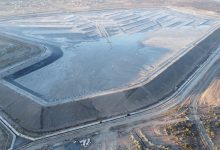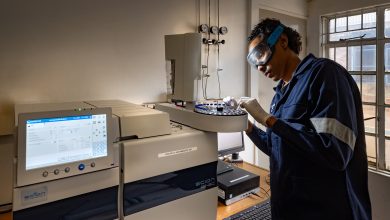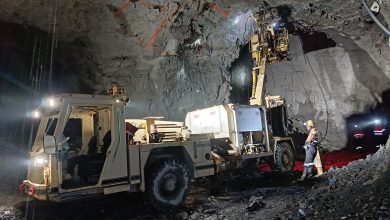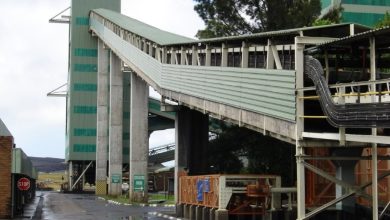
Grinding Mill Lining Selection for Semi-Autogenous (SAG) and Ball Mills
Correct Liner Selection, Optimal Mill Efficiency
Premature liner wear has a significant impact on mill availability. Data tests from regularly monitoring a mill’s operating conditions and liner wear life can be used to determine the design of the next set of mill liners.
By Jimmy Swira
Understandably, African mining companies have their sights set on the bigger picture of increased revenue. However, in this zealous pursuit, their major oversight could be neglecting smaller, yet crucial, details of their operations.
One such detail is mill lining performance. Though seemingly minor when looking at the full processing circuit, liner underperformance can add up over time and significantly hinder the realisation of larger goals. Many sites tend to reorder the same liners that were initially selected when their mill was installed. However, as conditions such as ore characteristics or operating parameters change over time, liners may no longer match well to the application, and problems can surface.
The Importance of a Quick Response
Accordingly, plant engineers need to act promptly once they notice that a reduction in the output of a ball or SAG mill corresponds with the wear of the mill lining. Nonetheless, finding the root cause and the best possible solution can be a challenge.
Mining Business Africa learns from a team of experienced application engineers from Metso how to tackle this challenge. This could have significant implications for mill throughput if left unattended.
Metso is a global provider of turnkey mill solutions, including equipment, relining machines, liners, and related services to diverse industries. The mill lining team has been consulting on mill lining-related matters for hundreds of projects worldwide, including Africa, for decades.
Sum of Many Parts
Drawing from this extensive experience, they share invaluable insights on optimising lining performance and addressing mill lining-related challenges. What is evident from their input is that optimising mill lining and grinding performance involves a sum of many integral parts, all working in sync.
Identifying Root Causes
At the outset, they underline the importance of identifying the root causes of common problems affecting mill production, which guides the approach to lining optimisation.
Production KPIs
Håkan Ståhlbröst, Head of Application Support and Value Creation: Mill Lining, asserts that, in most cases, changes in operating parameters and production key performance indicators (KPIs) can affect the wear life of mill linings as well as the actual liner performance. These KPIs include the charge level in the mill, the speed of the mill, the condition of the media, and the ore feed (percentage blend of feed materials) to the mill. Continuously monitoring these KPIs can provide data that makes it possible to anticipate how the wear will progress, and it is also the base for optimisation of future liner generations.
Key Elements at the Design Stage
Based on the data gathered, the following elements should be considered to determine the design of the next set of liners:
- Materials for Construction
During the design stage, Metso uses known data and optimises the liners according to that, Ståhlbröst explains. “To optimise liner wear life and get balance between different sections of the mill, the liner material can be redistributed so we move excess material from a low-wear area in the mill, making the liner thinner, and instead increase the height/thickness in a high-wear area. It is also possible to change the actual rubber compound or metallic alloy to better meet the wear life targets.” - Variables Impacting Grinding Performance
Lifter profile, height, quantity, and overall volume are the primary lining design variables that impact grinding performance. Consequently, Ståhlbröst advises, “It is desirable to have a well-balanced lining where different parts wear out concurrently while retaining an efficient profile over the life of the lining.” - Fluctuations in Rock and Ore Quality
Another factor to consider in liner design is that rock and ore are natural materials with variable properties. A lot of control and skill are needed to operate a comminution circuit in a reasonably steady state, meaning that both smaller and larger fluctuations must be anticipated.
Thus, a lining with a long service life that doesn’t infringe on the mill volume and matches the overall liner life with reline intervals is required. On how to create a suitable design, Ståhlbröst suggests, “It is important to monitor every single mill in detail regularly, capture and anticipate these changes, and optimise the liner design accordingly. Typically, liner design constantly evolves over the life of the asset.”
Liner Design Configuration
Asked about determining the best liner material and geometry, Cameron Mather of Technical Sales Support (Consumables) for the African market explains that the starting point is understanding that every mill has unique lining requirements. He highlights customer KPIs, critical mill operating conditions, and actual mill design and drilling patterns as key factors in design configuration.
Customer KPIs
“The first step in design is aligning with customer KPIs, such as targeted mill throughput, expected liner wear life, mill availability, and scheduled maintenance planning. Additionally, understanding existing bottlenecks and constraints and connecting these details with short- to medium-term mine planning are essential inputs,” Cameron explains.
Critical Mill Operating Conditions
Secondly, critical mill operating conditions are factored in. Usually, Metso uses a mill-lining questionnaire and other sources to gather this information from the miner. At this stage, any restrictions on current mill operations are explored, and correct answers to the following questions are sought: Is the mill weight limited or volume limited? Are there mill reline machine capacity limitations to consider? What is the mill ramp-up time following new lining installations?
Mill Design and Drilling Patterns
The design, size, and features of the mill itself and the way it is drilled for liners can sometimes limit or affect the liner design options and to what extent it can be optimised. Hence, when a new Metso mill is ordered, the team can consider not just the initial liner and the project mill design criteria but also future anticipated changes in process or service that might require a different liner design and layout. Liner interfaces are optimised for Metso mill reline machines to improve safety and relining times. Finally, the design of the equipment considers the best possible mill lining solutions to maximise the machine’s output and enhance operational efficiency.
Choice of Liner Material
The actual liner design and choice of liner material depend on several factors:
- Mill Type, Operations, and Ore Type
The type of mill, how it is operated, and the type of ore being processed greatly affect the selection of liners. Ståhlbröst explains, “Some mills require a lot of charge motion, promoting more impact breakage, while others need less charge trajectory as they rely more on attrition. This means that in one case, the liners must be more profiled, and vice versa.”
Chiming in, Nick Green, Vice President of Horizontal Mills, discusses the impact of the pulp discharge system. He notes that, in primary grinding mills, pulp discharge system configuration, wear life, design, and capacity are equally important elements of the grinding mill lining system design. “Where applicable, a pulp discharge system can be accommodated in the lining design for primary grinding mills with high volumetric throughput. In these types of mills, due to pulp discharge system capacity constraints, grinding efficiency may be reduced due to excessive slurry build-up in the grinding chamber, or the wear life of certain pulp discharge system parts may dictate shutdown intervals.” Overall, the manner of mill liner wear, or the design of the pulp discharge system, will influence how well the mill performs.
- Application
Similarly, when selecting liner materials, the specific application must be the primary consideration. Some materials are very abrasion-resistant but also brittle and not good at absorbing heavy impact.
Conversely, more impact-resistant materials might be less abrasion-resistant and deform more easily. To counter this, Ståhlbröst stresses that it is imperative to select the best option. “For example, if you are grinding hard gold ore that requires an abrasion-resistant material, but you are using a SAG mill with a lot of impact, we will select a material with high impact resistance to prevent liners from cracking and breaking but also with reasonable wear resistance,” he illustrates.
Sometimes, appropriate abrasion resistance can be achieved by mixing and applying different materials where their properties yield the best possible result. This is demonstrated by Metso’s Poly-Met liners, which consist of wear-resistant metallic inserts and flexible rubber. Another benefit of mixed-material liners is that they tend to retain a more efficient profile throughout the service life of the liner.
- Customer Objectives and Preferences
Ultimately, the mill’s owner makes the final decision, depending on their respective objectives and preferences.
Post-Installation
Selecting and installing the liners, however, is only half the battle. Even more vital is ensuring that the mill’s output fully meets expectations. This involves meticulous steps to optimise wear liner life and better plan maintenance shutdowns.
Post-installation, Mather emphasises the significance of keeping mill operation within the mill lining design specifications to provide maximum grinding efficiency and optimal mill shell protection.
Ståhlbröst adds, “The mill liner and the way it wears, or the design of the discharge system, will influence how well the mill performs. Therefore, it is equally important to track the mill performance and evaluate if the liner can be further optimised to improve grinding efficiency.”
To attain optimal grinding efficiency, maintaining operating conditions is vital. These include charge level percentage, mill speed, feed rate and feed size, and grinding media size.
By and large, continuous performance and wear life monitoring of the installed mill lining should be standard practice to avoid unexpected problems, allow for better maintenance planning, and ensure timely parts sourcing. By measuring or scanning the liners, current and historical wear rates and wear behaviour can be established.
Subsequently, the information gathered during regular inspections can be used to: better predict the remaining wear life of the liners; develop and optimise the next generation of liners; extend the service life to specific maintenance cycles; optimise liners to last a certain timeframe (to increase mill uptime); minimise weight and cost; and plan reline intervals.
Fundamental Truths
To cap it all, Ståhlbröst underscores two fundamental truths for plant managers regarding design and liner wear life as they pursue liner optimisation.
“As ore properties and the process generally change over time, there is no such thing as the ultimate liner design. Therefore, performance should be continuously monitored to ensure that the liner design is always optimised for the current conditions.”
“We have all the technical prerequisites to monitor critical parameters in a mill. However, the mill conditions and the wear life of mill liners are affected by multiple factors, each of which can influence the outcome in several ways. If something small is changed upstream in production, it will affect several factors downstream, making the process very complex.”
The long and short of it is that correct liner selection is a key factor in optimising grinding mill efficiency. However, with conditions always changing – optimisation needs to be viewed as a journey – and one best travelled with a trusted partner who can act as a guide along the way. Working with a partner who truly understands grinding inside and out, from the initial mill selection to the choice of liners, as well as understanding the best selection of Mill Reline Machine (MRM) and related services, can also pay dividends.






